Introductory remarks: Mesozoic Foramifera (The Triassic forams)
The Mesozoic followed on the heels of two mass extinctions which wiped out approximately 90% of foraminiferal genera. Most larger benthic foraminifera disappeared (ie. Fusulinina), however, smaller, simpler forms (i.e., Textulariina) only lost about 30% of total genera.
The Triassic larger foraminifera have not been systematically studied on a global scale like the Permian forams have. Rettori (1995) presents a revised taxonomoy of the Early and Middle Triassic taxa and Pybernes i
n De Gracianski et al (1988) presents a stratigraphic summary of forams in the Tethyan realm. Please refer to these as well as Chapter 3 of BouDagher-Fadel (2008) for more in
formation and detail of the taxonomy during this geologic period. Here, we present a brief summary and morphological classification of the genera characteristic of the Triassic, compiled predominantly from BouDagher-Fadel (2008).
The Triassic large benthic foraminifera are developed in five suborders (Textulariina, Fusulinina, Involutinina, Miliolina, Lagenina). The development and evolution of the superfamilies of these suborders is shown in the figure to the left. Most of the Triassic forams are relatively morphologically small, although they are distinguishable in thin section so are identified as "larger benthic foraminifera".
SUBORDER TEXTULARIINA
- Test: made of foreign particles bound by organic cement
- Geologic range: Early Cambrian to Holocene
Superfamily AMMODISCOIDEA
- Test: subspherical or tubular
- Aperture: at end of tube
- Geologic range: Early Carboniferous to Holocene
Family Ammodiscidae
- Proloculus followed by an uncoiled non-septate tubular second chamber
- Geologic range: Early Cambrian to Holocene
- Significant genera: Gandianella, Glomospira, Glomospirella, Pilammina, Pilaminella, Paulbronnimannia
![]() 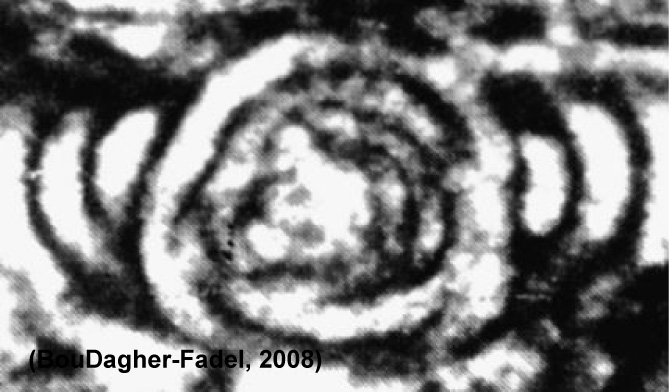 |
Gandinella
Test: Partly stretospiral
Geologic range: Early to Late Triassic
|
![]() 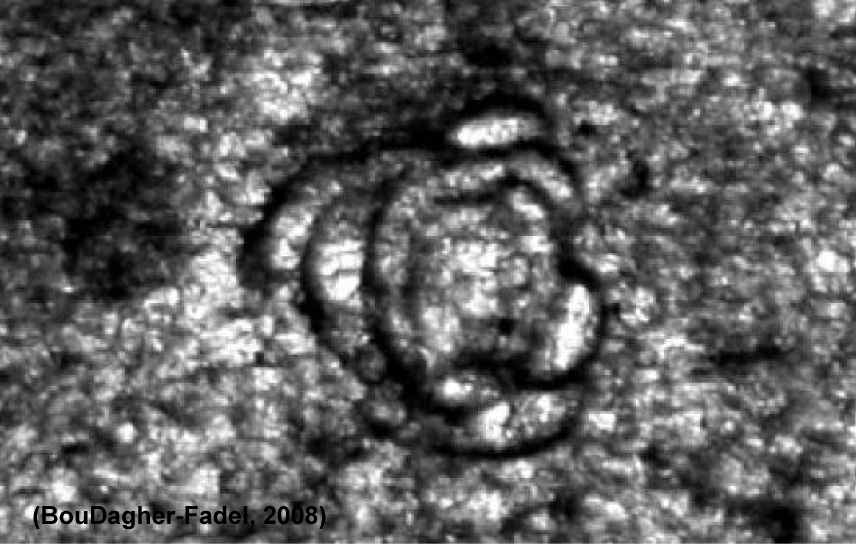 |
Glomospira
Test: First chamber followed by a streptospirally irregularly coiled chamber with terminal aperture
Geologic range: Early Carboniferous to Holocene
|
![]() 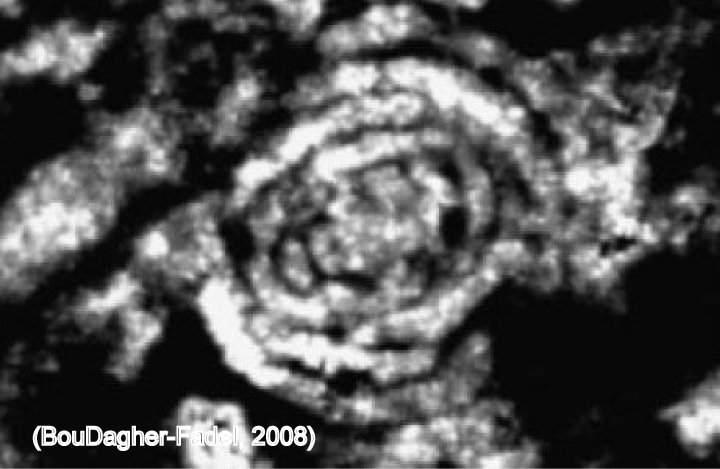 |
Pilammina
Test: Spherical prooculus follwed by a narrow non-septate elongate second chamber
Geologic range: Early to Middle Triassic
|
Superfamily ATAXOPHRAGMIOIDEA
- Test: multilocular, trochospiral becoming biserial or uniserial in later stages
- Geologic range: Middle Triassic to Holocene
Family Ataxophragmiidae
- Chamber: three or more per whorl in early stages
- Aperture: high and terminal
- Geologic range: Late Triassic to Paleocene
- Significant genera: Palaeolituonella
Superfamily COSCINOPHRAGMATOIDEA
- Test: members of this family are attached; may be coiled in early stages and later uncoiled or branched
- Geologic range: Triassic to Holocene
Family Coscinophragmatidae
- Wall: canaliculated perforate with alveoles
- Geologic range: Late Triassic to Holocene
![]() 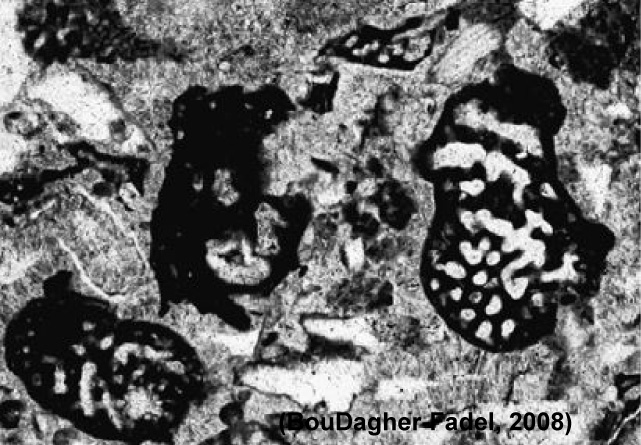 |
Alpinophragmium
Test: Spherical prooculus follwed by a narrow non-septate elongate second chamber
Geologic range: Early to Middle Triassic
|
Superfamily VERNEUILINOIDA
- Test: trochospiral throughout or only in the early stage; triserial, biserial or uniserial; some forms have a streptospiral initial part
- Aperture: single or multiple
- Geologic range: Late Carboniferous to Holocene
Family Piallinidae
- Test: multilocular, elongated with a proloculus followed by a trochospire throughout or with a small streptospire in the early stage followed by a high trochospire in the later stage
- Geologic range: Late Triassic
![]() 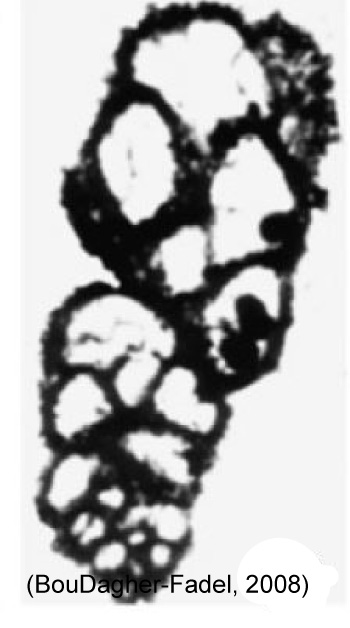 |
Piallina
Test: Spherical prooculus follwed by a narrow non-septate elongate second chamber
Geologic range: Early to Middle Triassic
|
SUBORDER FUSULININA
- Wall: microgranular without optical alignment; advanced forms have two or more differentiated layers in the wall
- Geologic range: Silurian to Late Triassic
Superfamily EARLANDIOIDEA
- Test: free, non-septate with a globular first chamber and a straight tubular second one
- Geologic range: Late Silurian to Early Triassic
Family Earlandiidae
- Chamber: single, free
- Geologic range: Late Silurian to Early Triassic
![]() 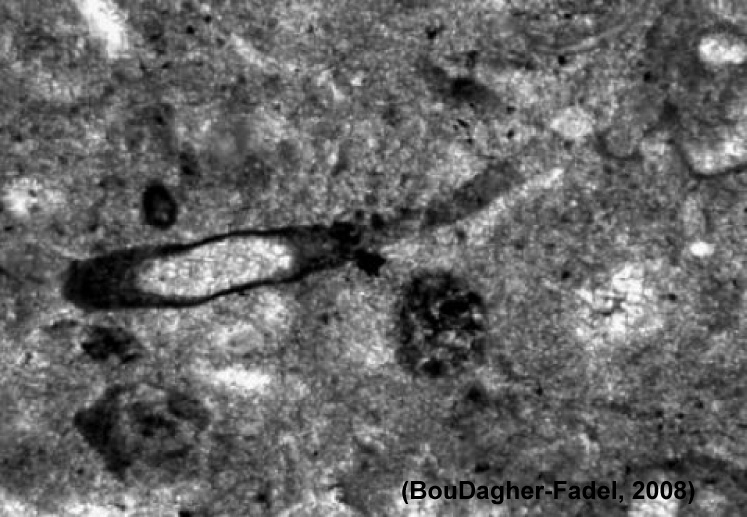 |
Earlandia
Test: free, elongate, composed of a globular proloculus followed by an undivided straight tubular chamber
Wall: calcareous, microgranular
Geologic range: Late Silurian to Early Triassic
|
Superfamily ENDOTHYROIDEA
- Test: streptospiral to planispiral with many chambers, followed by a rectiniliear stage, which is biserial or uniserial in some forms
- Wall: microgranular, calcareous, but some forms show two to three distinct layers; others may develop an inner perforate or keriothecal layer
- Geologic range: Late Devonian to Triassic
Family Endotebidae
- Test: free planispiral in early stages, later uniserial to biserial
- Wall: calcareous agglutinated, grey, thick with simple aperture
- Geologic range: Late Permian to Triassic
- Genera: Endoteba, Endotebanella
Family Endotriadidae
- Test: trochospiral almost planispiral, may be uniserial in later stages with a microgranular wall and basal, simple aperture
- Geologic range: Middle to Late Triassic
- Genera: Endotriada, Endotriadella
The figure to the left below depicts the evolutionary path of the Endotebidae from the Endothyridae (Earlandia) (Vachard et al., 1994). The endoteba has a compressed axial view and the endotebanella is similar but the final stage is uniserial. The endotriada has hemispherical chambers while the endotriadella is uniserial.
SUBORDER INVOLUTININA
- Test: All forms of this suborder have an enrolled second chamber with an aragonitic but commonly recrystallized wall to give a homogenous microgranular structure. The umbilical region has pillar-like structures on one or both sides of the test.
- Geologic range: Early Permian to Late Cretaceous
The figure above depicts the evolutionary lineages of the main genera of the Involutinina (BouDagher-Fadel, 2008)
Superfamily INVOLUTINOIDEA
- Test: a first chamber followed by a planispiral to trochospiral enrolled tubular second chamber
- Geologic range: Early Permian to Late Cretaceous
Family Triadodiscidae
- Test: the umbilical area is covered with additional lamellae added with each new whorl
- Geologic range: Early to Late Triassic
![]() 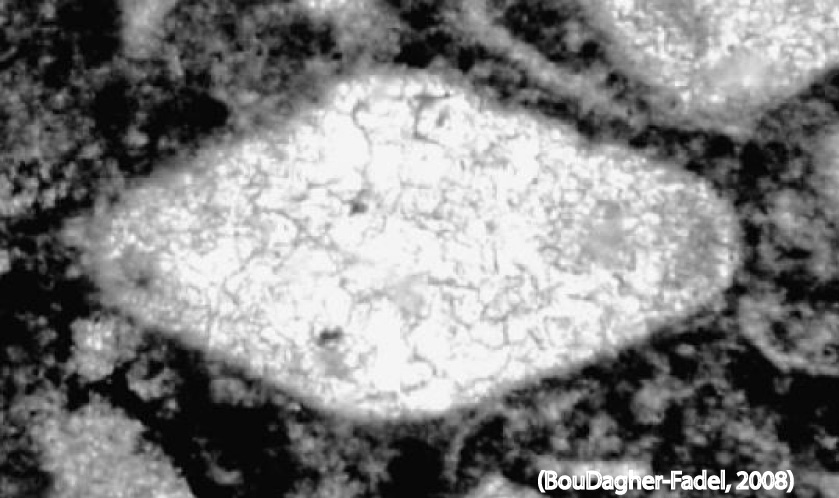 |
Triadodiscus
Test: lenticular with globular proloculus followed by a planispiral to slightly trochospiral and involute second undivided tubular chamber that is planispiral. Whorls are formed by a single lamella
Geologic range: Triassic
|
Family Aulotortidae
- Test: lenticular to conical with calcareous imperforate walls, consisting of a globular prolocular followed by a tubular enrolled and undivided second chamber, lying against the previous whorl to form planispiral, oscillating or trochospiral coiling. Each half whorl is followed by the lamellar deposition of one or two layers
- Aperture: at the open end of the tubular chamber
- Geologic range: Triassic to Middle Jurassic
![]() 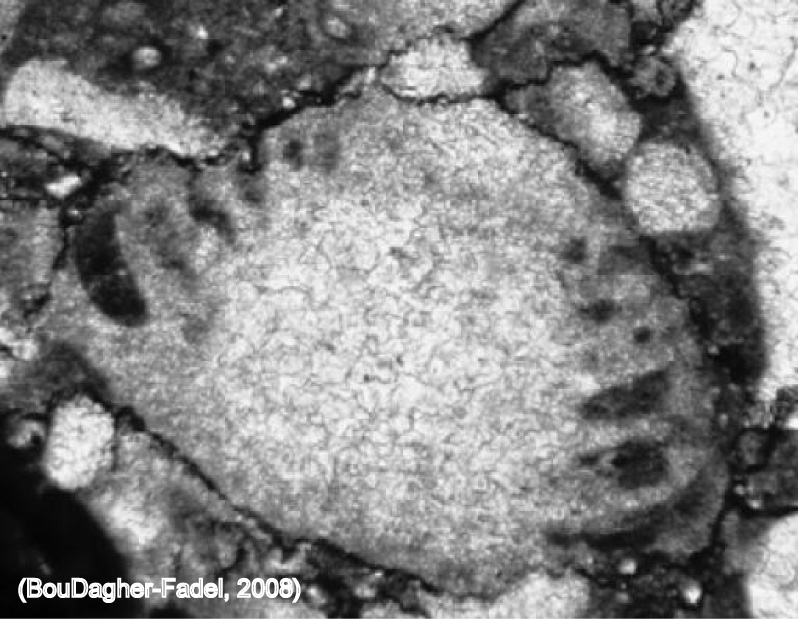 |
Auloconus
Test: The second chamber is a trochospirally enrolled tubular chamber. Each half whorl forms a lumina, which covers the umbilicus resulting in
the build up of a thick and solid umbilical filling.
Geologic range: Triassic
|
![]() 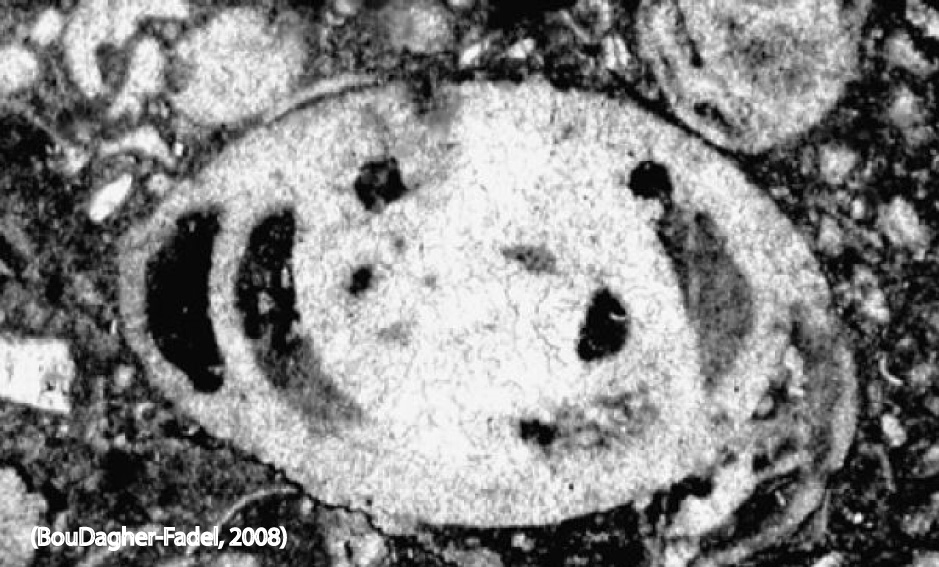 |
Aulotortus
Test: The enrolled second chamber is planispiral to slightly streptospiral, oscillating around the proloculus.
Geologic range: Triassic to Middle Jurassic
|
Family Triasinidae
- Test: with proloculus followed by a broad tubular chamber. The interior is filled wth cylindrical pillars
- Geologic range: Triassic
- Genera: Triasina
Family Involutinidae
- Test: globular proloculus followed by a trochospiral coiled tubular second chamber with secondary lamellar thcikenings on one or both umbilical regions
- Aperture: at the open end of the tube
- Geologic range: Triassic to Late Cretaceous
- Genera: Involutina; Semiinvoluta; Trocholina
![]() 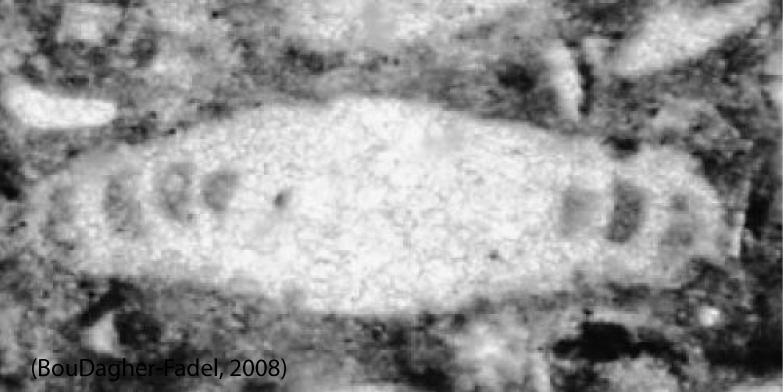 |
Involutinina
Test: Both umbilical regions are filled with lamellar deposits.
Geologic range: Triassic to Late Cretaceous
|
SUBORDER MILIOLINA
- Test: porcelaneous and imperforate, made of high-magnesium calcite with fine, randomly oriented crystals
- Geologic range: Carboniferous to Holocene
The evolution of the Triassic miliolines from a Permian ancestor (modified from Zaninetti et al, 1991; Rettori, 1995; BouDagher-Fadel, 2008).
Superfamily CORNUSPIROIDEA
- Test: free or attached, and composed of a globular proloculus followed by a tubular enrolled chamber. Coiling is planispiral or trochospiral, evolute or involute and may become irregular
- Aperture: simple and at the end of the tube
- Geologic range: Early Carboniferous to Holocene
Family Arenovidalinidae
- Test: lenticular with a globular proloculus and a second undivided chamber
- Geologic range: Early to Middle Triassic
- Genera: Arenovidalina; Paratriasina
Family Ophthalmidiidea
- Test: free, composed of a proloculus followed by an undivided coiled second chamber and chambers that commonly are one-half coiil in length
- Wall: porcelaneous
- Aperture: terminal and simple
- Geologic range: Triassic to Holocene
![]() 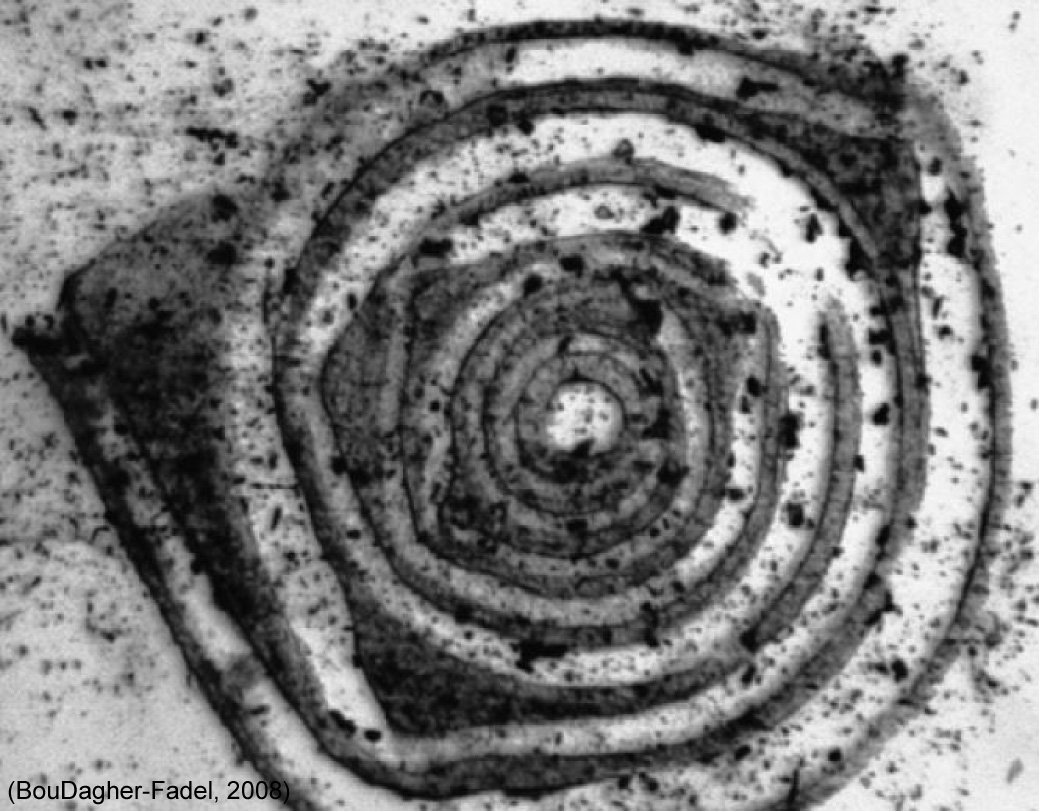 |
Eoophalmidium
Test: Involute coiling
Geologic range: Anisian
|
![]() 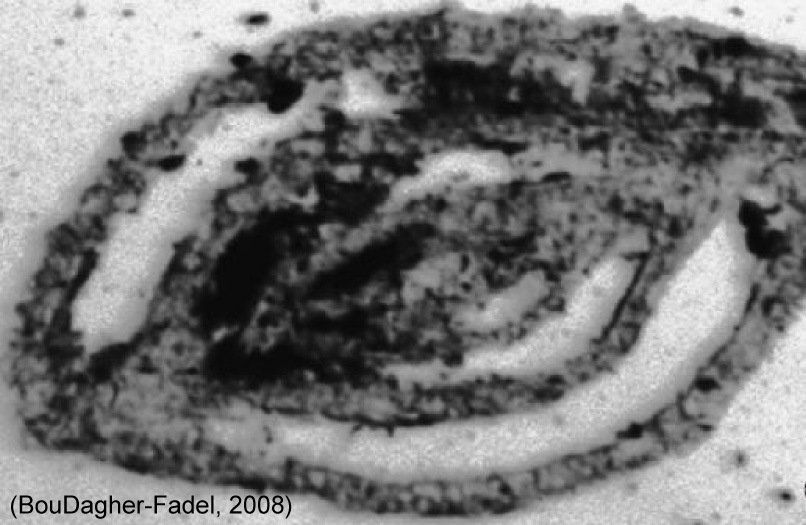 |
Karaburunia
Test: The proloculus is followed by sigmoidal coiling of two chambers per whorl, the final pair of chambers are approximately 180 deg. apart.
Geologic range: Triassic (Late Anisian)
|
Family Meandrospiridae
- Test: composed of a proloculus and an undivided second chamber with zigzag coiling
- Aperture: simple and terminal
- Geologic range: Permian to Holocene
- Genera: Meandrospira; Meandrospiranella; Turriglomina
Family Cornuspiridae
- Test: free or attached, composed of a proloculus followed by an undivided planispiral to streptospiral, involute or evolute second tubular chamber
- Geologic range: Early Carboniferous to Holocene
- Genera: Planiinvoluta
Family Hemigordiopsidae
- Test: at least an early streptospiral stage, that later may be planispiral.
- Geologic range: Early Carboniferous to Holocene
- Genera: Agathammina
Family Hoynellidae
- Test: free, with a globular proloculus followed by an early miliolid stage and an undivided tubular chamber arranged on several vertical planes
- Geologic range: Triassic to Early Jurassic
- Genera: Hoynella
SUPERFAMILY SORITOIDEA
- Test: chambers are planispiral, uncoiling, flabelliform or cyclical, and may be subdivided by partitions or pillars
- Geologic range: Late Permian to Holocene
Family Milioliporidae
- Test: free or attached with a proloculus and tubular chambers arranged in various planes of coiling which may be irregular, oscillating or sigmoidal
- Geologic range: Late Permian to Late Triassic
- Genera: Galeanella; Kamurana
SUBORDER LAGENINA
- Wall: monolamellar, composed of low-magnesium calcite in which the optical c-axes of the crystal units are perpendicular to the outer surface of the test. Primitive taxa are without secondary lamination, but more advanced forms are found with secondary lamination and a thin microgranular inner layer
- Geologic range: Late Silurian to Holocene
Superfamily DUOSTOMINOIDEA
- Test: enrolled, planispiral to trochospiral
- Aperture: single or double, interiomarginal
- Geologic range: Triassic to Early Jurassic
Family Duostominidae
- Aperture: two interiomarginal in the final chamber
- Geologic range: Triassic
![]() 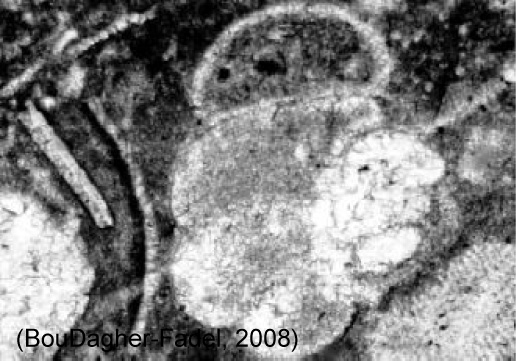 |
Test: lenticular, trochospirally coiled
Geologic range: Triassic
|
Superfamily GEINITZINOIDEA
- Test: uniserial, similar to the Nodosinelloidea but the microgranular layer is the
- inner dark layer, while the radially fibrous layer is the outer layer
- Geologic range: Late Devonian to Middle Triassic
Family Abriolindae
- Test: small, with trochospiral slightly curved sutures and subglobular chambers
- Geologic range: Middle Triassic
- Genera: Abriolina
Family Ichtyolariddae
- Test: elongate, uniserial with a single layered wall. Secondary lamination may be apparent
- Aperture: simple and terminal
- Geologic range: Early Permian to Early Cretaceous
- Genera: Austrocolomia; Cryptoseptida; Grillina
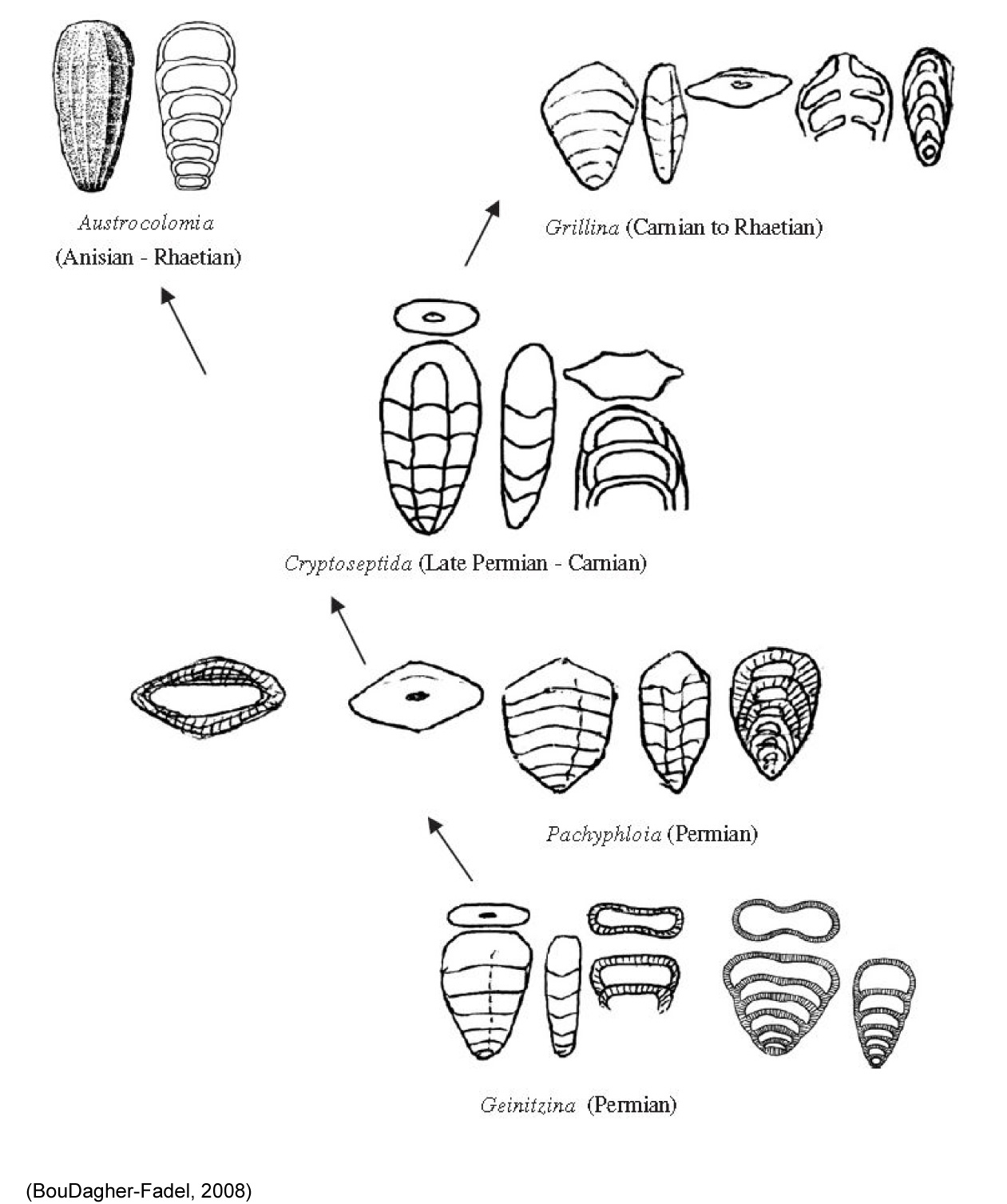
A schematic figure showing the convergence of lagenids features in the Late Permian as well as Late Triassic forms
Family Robuloididae
- Test: uniserial, enrolled with atelo-monolamellar wall construction
- Aperture: terminal
- Geologic range: Middle Permian to Late Jurassic
![]()  |
Robuloides
Test: nautiloid to lenticular with an acute periphery. It is
involute and planispirally or nearly planispirally coiled. A primary monolamellar wall covers the previous chambers (weakly to markedly plesio-monolamellar) so
that the umbilical region of the test appears as a nearly solid mass of calcite and the peripheral septa are oblique.Aperture: simple
Geologic range: Middle Permian to Midle Triassic
|
References
BouDagher-Fadel, M.K., 2008. Evolution and Geological Significance of Larger Benthic Foraminifera. Developments in Paleontology and stratigraphy, v. 21, 540p.
Rettori, R., 1995. Foraminiferi del Trias inferiore e medio della Tetide, Revisione tassonomica, stratigrafia ed interpretazione filogenetica. Universite´ de Gene`ve, Publications du De´partement de Ge´ologie et Pale´ontologie 18, p. 147.
De Gracianski, P.-C., Hardenbol, J., Jacquin, Th., Vail, P.R., 1998. Mesozoic–Cenozoic sequence stratigraphy of European Basins, Society of Economic Paleontologists and Mineralogists Special Publication, SEPM, Tulsa, OK, Vol. 60, 786pp.